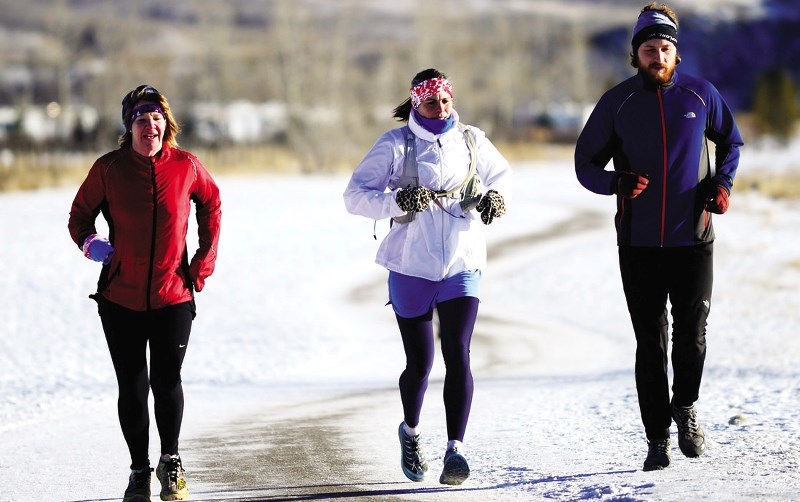Alberta winters can be harsh; running during the chilly season is even harsher. But if you don’t want to hibernate, and want to gain some mileage, 5 Peaks Adventures Ltd. CEO and trail runner Amy Golumbia has some advice for braving shorter days and freezing temperatures.
Golumbia said layering is key in combating the cold. She recommends starting with a base layer of wool with a “buff” (a tube of fabric that can be worn as a neck warmer or bandana. This will keep your shoulders from raising and throwing off your stride. Over top, she suggests a fleece sweater and an outer shell for blocking wind and keeping dry when the weather gets worse.
But she cautions against going overboard.
“The worst thing you can do,” she said, “is over dress and get too hot and sweaty. When you stop, you freeze.”
When it comes to shoes, there’re a number of options, Golumbia said. You can get shoes with Gore-Tex or waterproof your current pair. If you’re running in deep snow, a pair of Gators to go over top will keep the snow out entirely.
To give your shoes extra grip, Golumbia suggests products like Yaktrax or MICROspikes. Both products act like crampons for climbers in that they slip over shoes with a web of spikes or studs.
“When you’re running on ice or snow, you’re not going to slip.”
With the cold, comes cold muscles, so Golumbia said to give yourself more time warming up.
“If you go into it and your muscles are really cold, you could get injured.”
If the mercury dips below -30 but you still want to brave it, do your warmup inside before venturing outdoors. She cautions, however, not to get too sweaty since it will make you vulnerable to the chill.
The big thing here? Watch your footing and be on the watch for black ice.
“If it’s icy conditions, I won’t run without my MICROspikes. I’ve fallen too many times on my tail bone and it just takes too long to recover.”
If you’re headed off the road to parts less known, let someone know where you’re going. As long as you keep aware, trails can be great during this time of year, Golumbia said.
“The best part: no bears,” she laughed.
It’s no secret that staying committed during warmer seasons is probably easier than getting up on winter mornings, in pitch darkness, freezing air and endless snow.
“If you’re going get up early and run in the dark, that takes a lot of discipline.”
Golumbia admits that she often opts for the treadmill in the morning, with an outside run at lunchtime if time permits. “The daylight hours are so limited as it is in the winter. Even if it means going into the office early so you have a bit more time at lunch, that would be my suggestion for running through the winter.”
“Once you stop, you’re going to cool off really quickly and your muscles will start to seize up really quickly.”
After coming in from the cold, the quicker you can get out of your sweaty running garb the better, Golumbia said. That means putting dry clothes on even before you cool down to help warm up faster.
When you’re done with that, Golumbia is a big fan of soup from the crockpot and a cup of tea.




